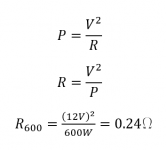nuckythompson
Member
- Location
- Nova Scotia
- Occupation
- Electrical
Hi there, I am looking at two heating elements, one is 12V, 300W and the other is 12V, 600W. The only physical difference is the size.
If I supply each heater with the same amount of current will I get the same amount of heat?
Ex. they are both 12V and if I supply 25A I should get 300W. Would the 600W element produce the same amount of heat and just have capacity for more? Will the 600W just heat slower?
Thank you!!
If I supply each heater with the same amount of current will I get the same amount of heat?
Ex. they are both 12V and if I supply 25A I should get 300W. Would the 600W element produce the same amount of heat and just have capacity for more? Will the 600W just heat slower?
Thank you!!

